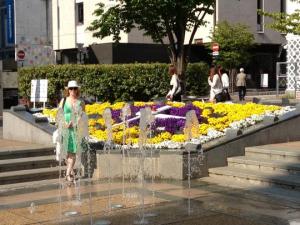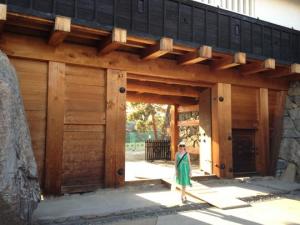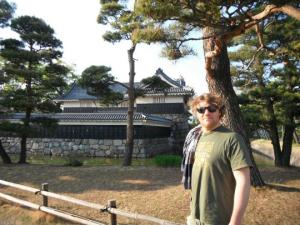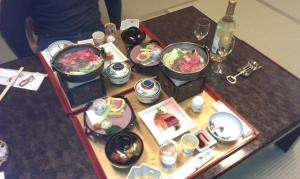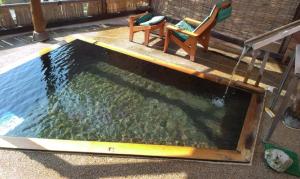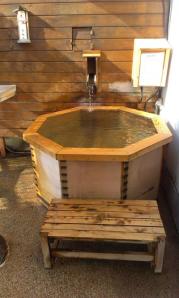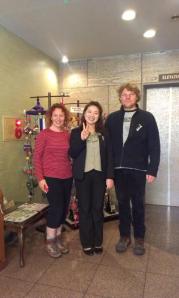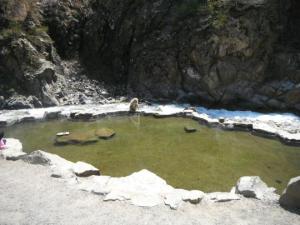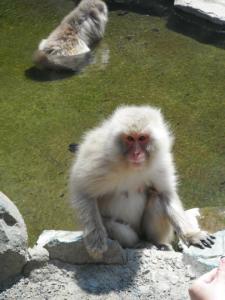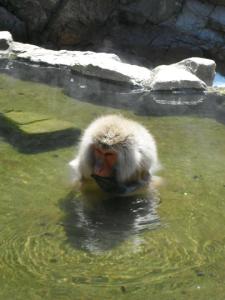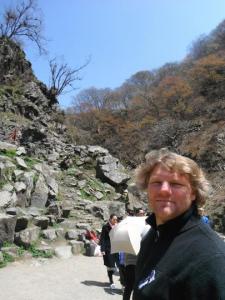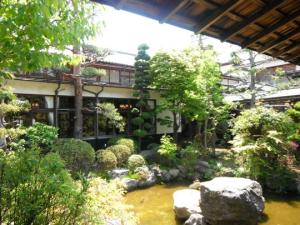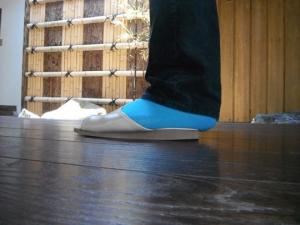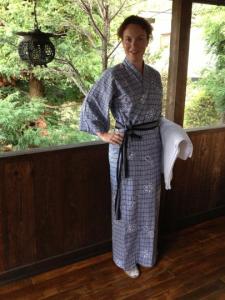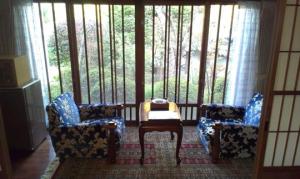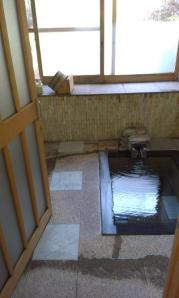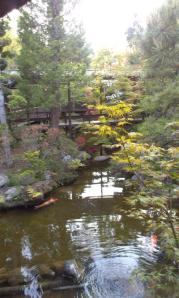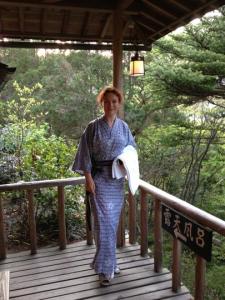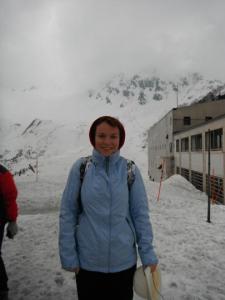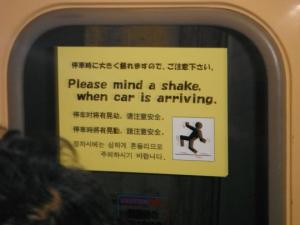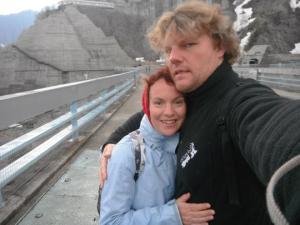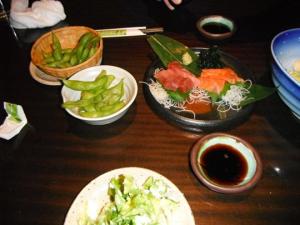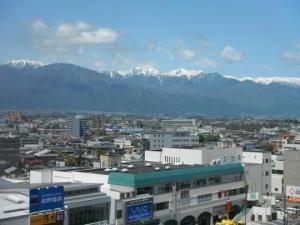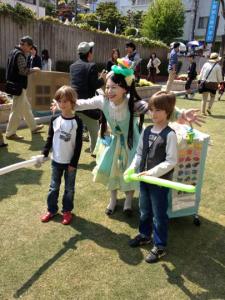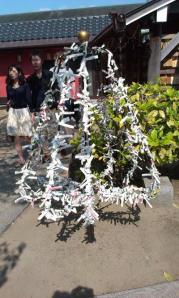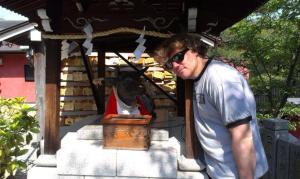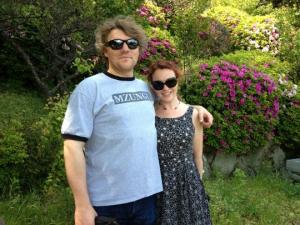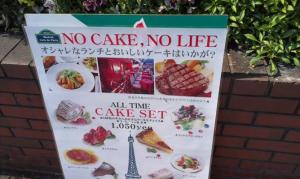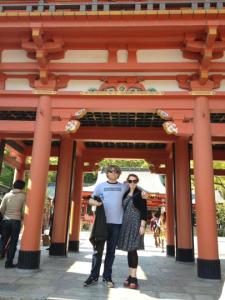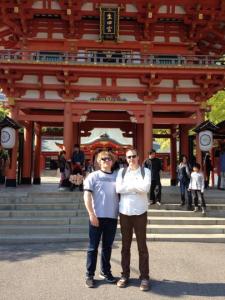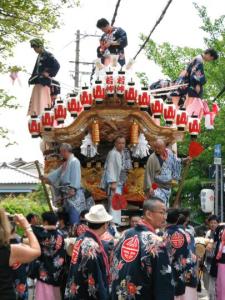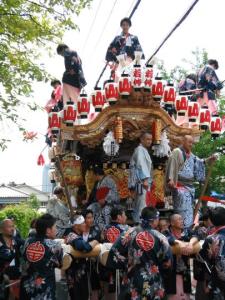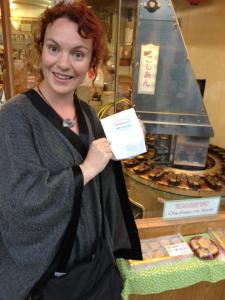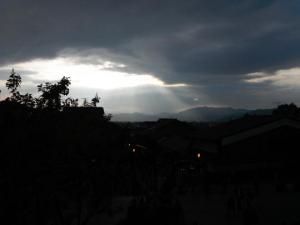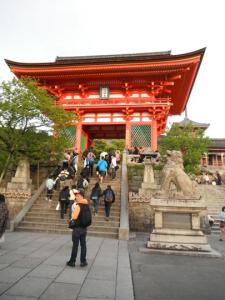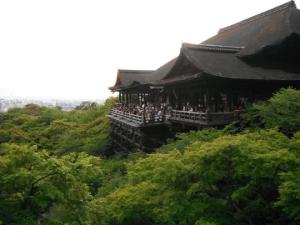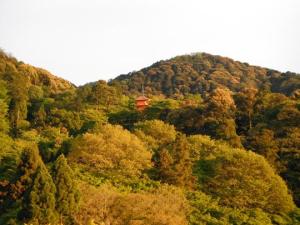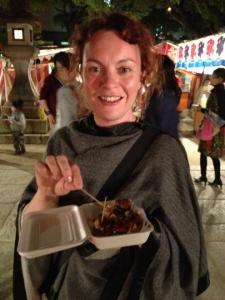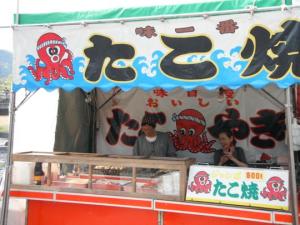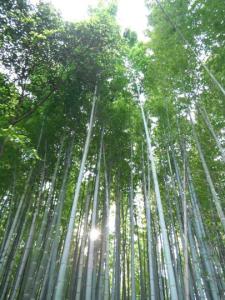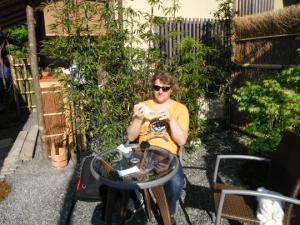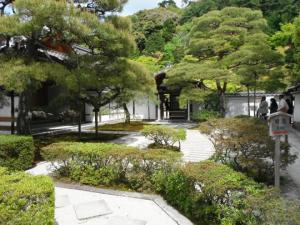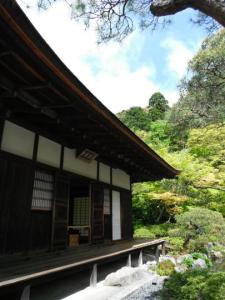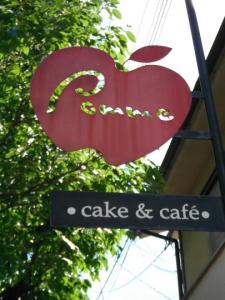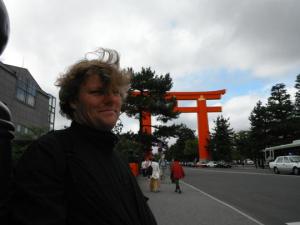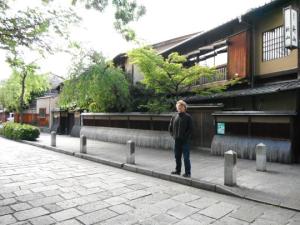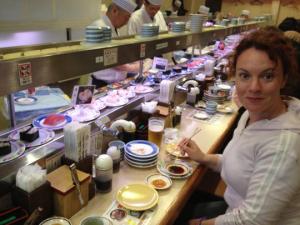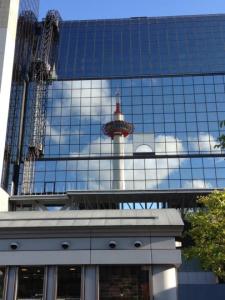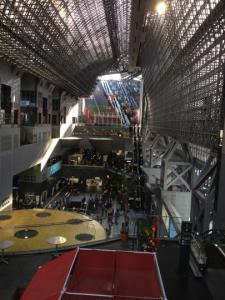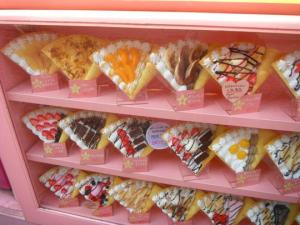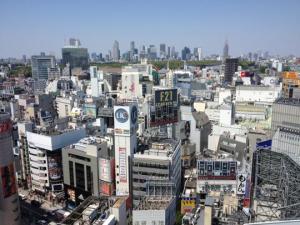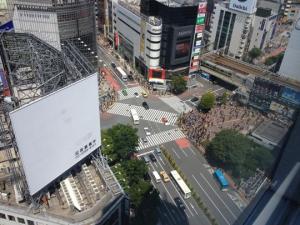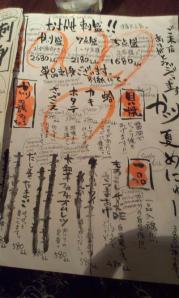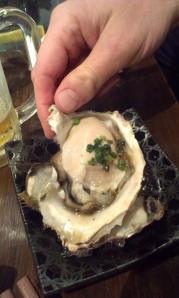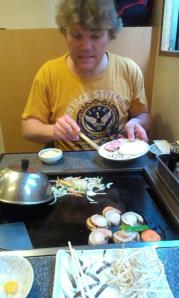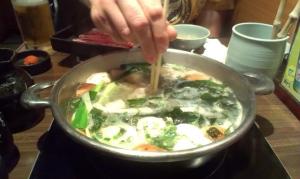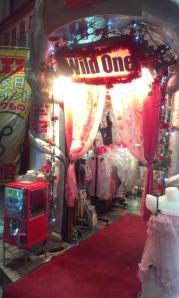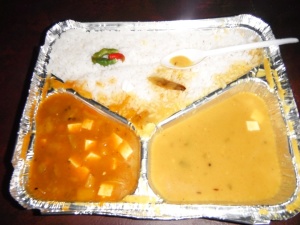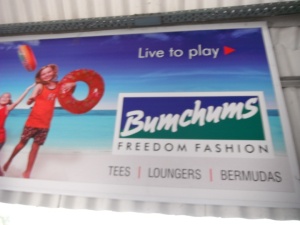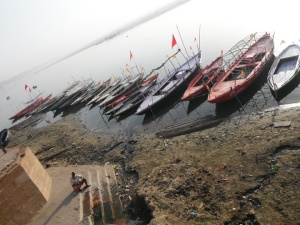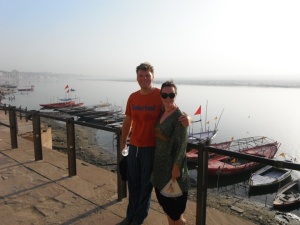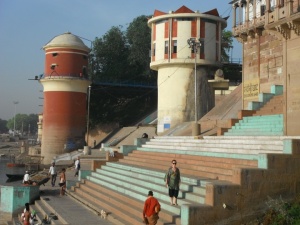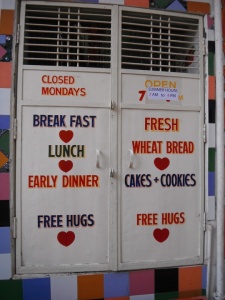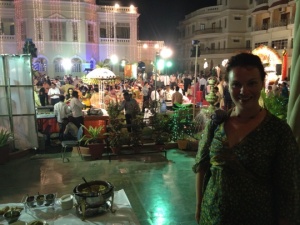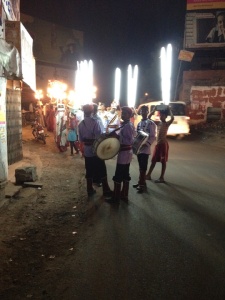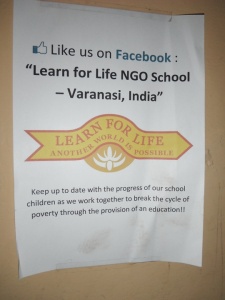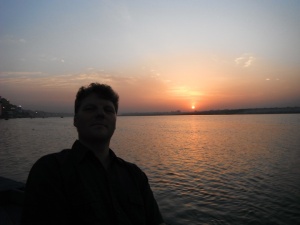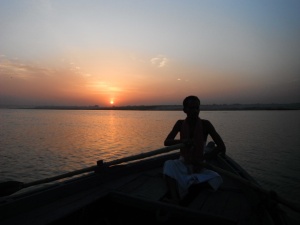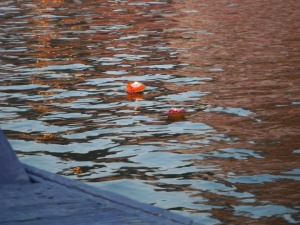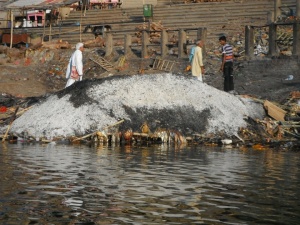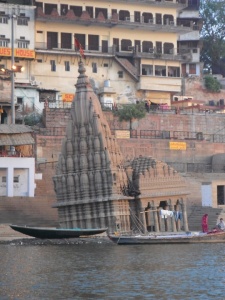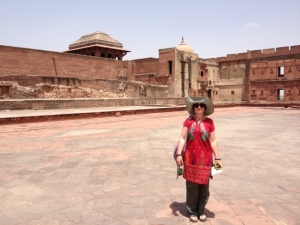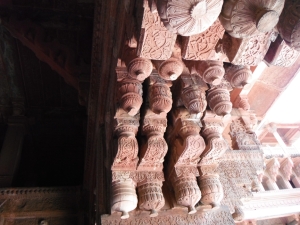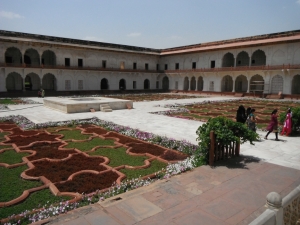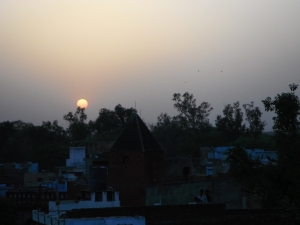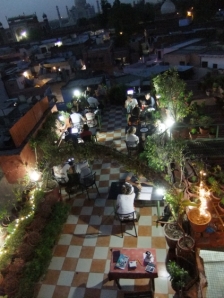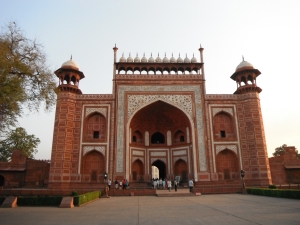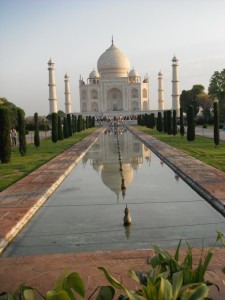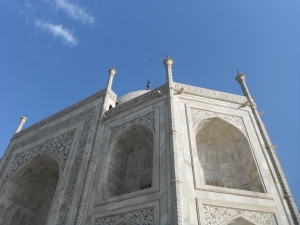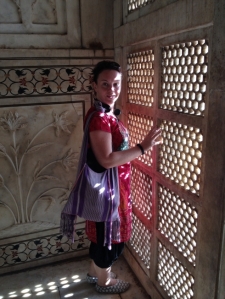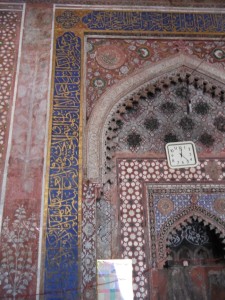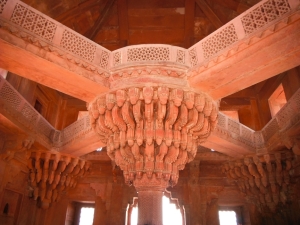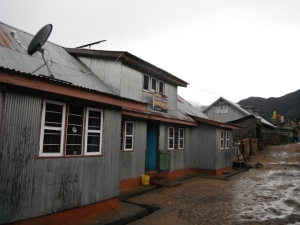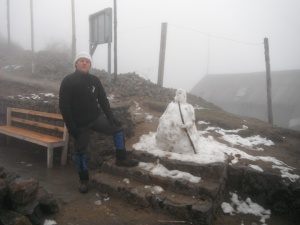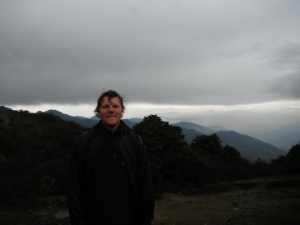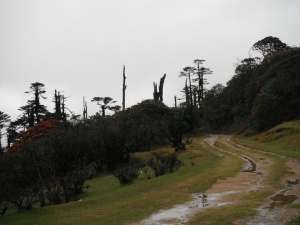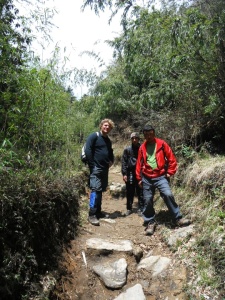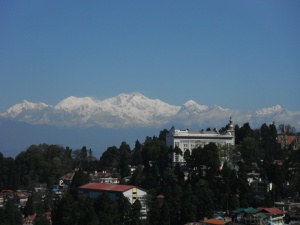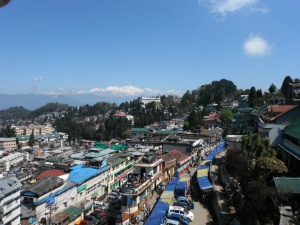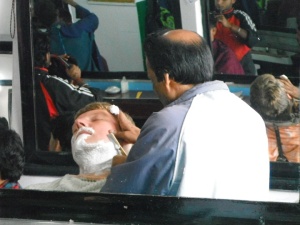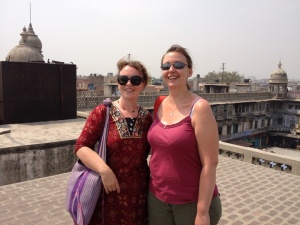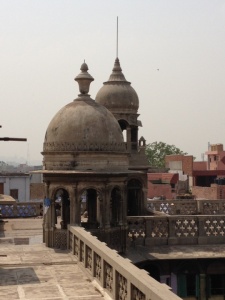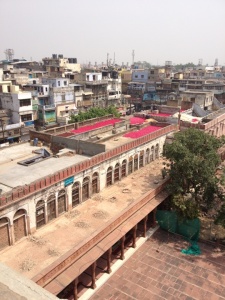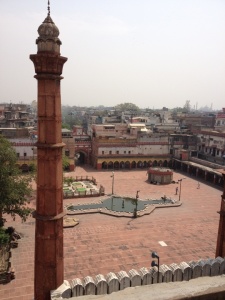Thursday 9th May 2013: Matsumoto
We dropped the car off at lunchtime in Matsumoto to give us time to have a wander about and also to post back to Martin and Tilly the spoon we had stolen to eat our yogurts on Monday. The people in the post office were so helpful and charming it made us embarrassed on behalf of anyone having to use the post office in UK and Spain when they can’t speak the language.
The castle, ‘Matsumoto-jo’ is one of four castles designated as ‘national treasures’, but it was closed by the time we got there. Still, from the outside it was quite lovely:
- Lovely Helen and Randall at Matsumoto Castle

Castle gates

Matsumoto nightlife
Tuesday 7th – Thursday 9th May 2013: Bessho Onsen and Nagano Snow Monkeys
We loitered in Matsumoto on Tuesday longer than planned as we had to wait for our luggage to arrive from Sumiyoshi – luckily we were able to track its progress online, so as soon as it arrived in town we had the hotel call the post office and summon our luggage thenceforth. Once we had rather relievedly received our luggage (despite reassurances from the guidebook and t’interwebs we were somewhat nervous about signing it over to some guy in a convenience store on Sunday) we headed across the road to the Nissan car rental where we had a reservation as they were the only rental place in town that dealt in Engrish.
Our plan was to visit the Snow Monkeys in Yudanaka, but by the time we arrived it was raining and almost time for the park to close, so instead we headed back to our ‘experience’ for the night, a stay in a Ryokan in Bessho Onsen , an ancient spa town mentioned in The Pillow Book .
Our ryokan for the night was Uematsuya Ryokan – not especially traditional or historical but reviewed as being friendly to non-Japanese with some English spoken. As the Onsen /Ryokan experience was billed as being very typical Japanese and not ‘touristy’ ie non-Japanese tourists, we thought this would be a gentler experience. We were right, as when we were just getting a bit concerned about finding the place and had pulled up to consult a map, we had a knock on the car window to find the lovely Wan-chen out to look for us in her car as we were late! She spoke great English and checked us in and explained how everything worked – a good thing as it was all rather complicated and we would have been exceptionally confused otherwise!
We had a traditional Japanese room with tatami mats, so all footwear to be removed before entering. They provided slippers as well as the yukata for moving around the ryokan, and even managed to find a biggish pair that weren’t too tiny for Randall.
As we’d arrived late-ish, dinner of traditional Japanese ‘haute-cuisine’ was served almost immediately in our room.
Really, it was the kind of meal where we couldn’t identify half the items, and very possibly ate the garnish in more than one case, but it was mostly very tasty – the sashimi was fantastic and the roast fish was pretty good too.
After dinner it was time to bathe – separate baths for men and women that get swapped over each evening so everyone gets a go in each of the indoor and outdoor baths.
The onsen are *not* for washing – you have to clean yourself thoroughly (so everyone can see you have!!) before getting in for a soak.
I had a beautiful solo bath in the outdoor bath, reading my book. It was dark at the time (these photos were taken the next morning) so there were lovely views of twinkling lights over the ceramic-tiled rooves of the houses in the town.
I am sooooo going to buy some yukata – they are so comfortable!
This reminded me of THAT Ewan McGregor scene in The Pillow Book (the 1996 Peter Greenaway film, not the original!)
Breakfast was served communally but very Japanese-style, on the floor on tatami mats – fish, seaweed, rice and pickles.
On check-out we had a photo with Wan-chen for their blog pages as they don’t have many western guests:
She also very kindly drove us to the next ryokan we were going to stay in (even though it was technically ‘the competition’) as she was concerned that no-one there spoke English and she wanted to ensure that everything was set up for our arrival, including leaving our bags there while we went off for the day. What a star – we highly recommend Uematsuya Ryokan to anyone.
So, now it was time for take 2 of the snow monkeys experience. This time we managed to get onto the highway instead of the local road, and Randall decided to be outrageous and ignore the 80km/h speed limit (usually I would object, but I could see it was doing bad things to his blood pressure) so we arrived in just over an hour with a stop for second breakfast (pickles and fish hadn’t really hit the spot).
On arrival at the monkey park (TERRIBLY signposted, in case you are ever considering it!) we paid 500 yen for parking and started the walk to the Snow Monkeys , duly warned:
Snow Monkeys!
Post-monkeys, we went for a short drive and hike around the Shiga-Kogen area (1998 Winter Olympics site).
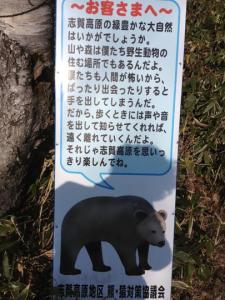
We were a little concerned in case this sign – at the start of our walk – said ‘beware of the bears’.
Then it was time to head back to Bessho Onsen fo some more hot water action:
The beautiful, historical and traditional Hanaya Ryokan has been serving travellers since the 17th century. It was a wonderful experience although we were glad we had warmed up at Uematsuya Ryokan the night before, as very little English was spoken and it would have been completely baffling otherwise!
Our lovely little house, with private onsen:
Hanaya Ryokan
The gardens were stunning – all fantastic levels of trees and shrubs, koi carp pools, little wooden bridges and walkways – just gorgeous:
We didn’t manage to photograph the outdoor baths or the ‘Observation bath’ as they were populated but both were absolutely lovely, however we didn’t use them as we had the luxury of our own private one in our suite!
Dinner was served in our room as is traditional:
Monday 6th May 2013: The Alpen Route, Japan Alps.
The plan was to do the supposedly spectacular Alpen Route , leaving early from Martin and Tilly’s on Monday morning and arriving at the other end in time for the last train to Matsumoto, having seen some spectacular views and done some short hikes along the way.
When we took the first two modes of transport – the train from Toyama to Tateyama and then the ‘cable car’ (funicular to us) for the first 500m up the mountain – this still looked reasonable.
However by the time we were at about 1500m, about halfway to Murodo on the bus, a heavy mist had rolled in and the snow was starting to fall as we drove through the famous snow corridor:
Snow Corridor
In Murodo, at 2500m, we’d been planning to hike around the pretty lake there and maybe even visit the ‘Hell Valley’ , although we saw a sign that the latter was closed to walkers because of dangerous gases released by recent increased ‘fumarolic’ volcanic activity. However there was such a white-out at the top that walking really wasn’t on the cards:
So we took the next three means of transport; the electric ‘trolley bus’ through the tunnel, followed by the spectacular, over 1000m single-span cable car / ropeway and then another funicular down to the Kurobe dam:

Kurobe Dam
From the dam the final means of transport were another electric trolley-bus, then a local bus for half an hour, then finally a JR train to Matsumoto to check in to our hotel for the night.
We found an izakaya near the hotel for food and a couple of beers while listening to locals be raucous (well, mainly local girls be squeaky and screechy!) before crashing for the night.
Needless to say, the next morning the mountains were clear and the sky was blue!
Friday 3rd – Sunday 5th May 2013: Sumiyoshi, Kobe, Osaka and Kyoto
On Friday morning we left Kyoto and travelled by taxi, VERY crowded JR Special Rapid service to Osaka and then local train to Sumiyoshi, to stay with the lovely Martin and Tilly – old friends of Randall’s – and their two delightful 7-year-old boys.
It was a festival weekend – part of Golden Week – and in Kobe (their nearest town) there was a flower-petal festival a bit like the one in Sitges for Corpus Christi:
We wandered up through Kitano to the temple/shrine at the top of the hill via a small plaza where an audience of locals were enjoying watching a performing monkey – little outfit, glasses and all. Cultural differences…
The boys had been learning how to make origami Samurai hats:
That evening we headed into the bright lights of Osaka, although apparently it was very quiet compared to usual as it was a holiday. Still, we met one of Martin’s work colleagues and had a great dinner and some beers in a Japanese/Hawaiian fusion place.
The Osaka Station Water Clock
The next morning Randall and I slept late, and were surprisingly not woken by a noisy parade banging and crashing its way past. However luckily there was another so we didn’t miss out:
The moving shrine parade
It was really quite spectacular, with all the local children ‘pulling’ the cart up the road on a long rope, and teenagers hanging off the roof at alarming angles waving their flags and chanting.
The moving shrine parade #2
Even better, the local fire service were supervising the proceedings and gave Tom and Jack a ride in the fire engine!
It was late-ish before we caught the train to Kyoto to go shrine visiting – a bus from the station took us close to Kiyomizu-dera, we walked the rest of the way up the hill lined with little cafes and curio shops.
It was early evening by the time we arrived, but as it turned out that meant that the light was just amazing.
By the time we got back to Sumiyoshi it was late evening and there was a festival going on around the local shrine with stalls for winning goldfish etc and most importantly great street food, so I finally got the takoyaki I’d been fixated on since reading ‘Sushi and Beyond – what the Japanese know about cooking’ (thanks Symon and Zoe for the recommendation!).
On Sunday Tilly was feeling under the weather so the rest of us headed off to Arashiyama on the outskirts of Kyoto to the famous Bamboo Forest. It was a beautiful day so we first went boating on the river:
Being in a rowing boat with Randall – particularly when you are responsible not only for navigation but also for the well-being of a sevenyear-old without a life jacket – is not the most relaxing as one travels everywhere at full ramming speed. A bit like when Obelix rows. Still, it was very picturesque and we only had a couple of collisions.
Our first attempt at taking on supplies failed – just as we were ordering from the nice lady someone leapt into their boat, shouted a command and they zipped off at high speed. The second attempt was more successful and we managed some drinks and popcorn before drifting away to make space for the next customers.
All that rowing (or in my case lounging in the back of the boat) had made us hungry – time for more takoyaki!
From here we headed to the actual bamboo forest:
In rather typical Japanese fashion it was all very regulated – no wandering through little meandering paths in the forest, just a wide tarmac path along with the other tourists, the rickshaws and the bicycles. It was pretty but not overwhelming, so Martin took Caroline and the boys back via the temple while Randall and I continued walking for a little while and then found a spot in the sun for a couple of beers:
We headed back to Sumiyoshi in time to drop off our luggage at a convenience store for the apparently famous Japanese luggage forwarding service as the next day we were heading to the mountains for the Alpen Route where big bags aren’t allowed. We hope to see our luggage again soon.
Our stay was rounded off by a night out in Kobe with live music by The Tardy Boys – drinking, dancing and much fun!
Kobe by night
Tuesday 30th April – Friday 3rd May 2013: Kyoto
I’d been pretty excited about the bullet trains but they turned out to be almost exactly like the AVE between Barcelona and Madrid (which is, it has to be said, VERY cool!). In fact, in business and first class on the AVE they actually feed you whereas Green Class on the Shinkansen had a trolley service. Still, it was clean, fast and efficient, getting us to Kyoto in 2.5 hours (distance of about 450km)
Our Kyoto hotel, the Hearton, turned out to be 3 stops on the subway from the main station (thanks to Randall for carrying my suitcase up and down I don’t know how many stairs – they don’t do ‘accessible’ in Japan) and right in the middle of town, so once checked in and sorted out (free wifi in the lobby only) we were able to walk through Nijo-dori, a street with numerous cafes and restaurants, to the river. The restaurants with riverside terraces all seemed to be traditional Japanese places doing expensive set menus, but we found a café and had a bottle of sparkling wine and some Japanese-Italian fusion antipasti with delightful service.
On the way home we called in at the Hello Cafe Bibliotec for tea and cake in my case and coffee and milkshake for Randall.
Our hotel turned out to be a mid-range one catering to tour groups and business meetings, so reasonably international while still being small-ish. It turned out to do a well-priced breakfast buffet with a mix of western and Japanese items so the next morning we indulged ourselves with bacon, eggs and coffee. Just as well, as finding the kind of cheap-and-cheerful food we’d mainly been eating in Tokyo turned out to be a bit more tricky in Kyoto.
Time for some sight-seeing. With instructions and a map from the hotel reception we managed to successfully negotiate taking a local bus to the Ginkaku-ji (Silver Pavilion) temple at the start of the Philosopher’s Walk .
Somewhat hungry already, we tried the green tea cream buns on offer (not recommended)…
…before starting down the canalside walk and finding the lovely Pomme café, where a charming gentleman served us drinks and slices of cake homemade by his wife:
At the end of the Philosopher’s walk we headed towards town with the idea of following the streams as far as Gion, the famous geisha district. We couldn’t resist popping into the Lake Bawa Aqueduct Museum but gave the Zoo and the National Museum of Art a miss.
Following the canals was a pretty journey through residential areas…
…but when we finally arrived in Gion it was something of a disappointment. On Shirakawa street, tipped as ‘one of the most beautiful streets in Asia’, only a few of the original tree-lined streets with wooden houses remain…
…and they are surrounded by concrete monstrosities full of what seem to be essentially brothels. As it was now after 3pm we couldn’t get food anywhere (everything seems to close between 3 and 5 or 6) despite walking all the way up Pontocho so we headed back to Café Bibliotec for a snack and a bit of a sit-down with our books.
Hungry again, we headed down to the Sanjo-dori covered shopping arcade in search of a recommended Kaiten-sushi place. This time we were actually successful! While it wasn’t the most stylish and sophisticated sushi, it was fun and cheap and we ate loads before staggering back to the hotel for an early night.
On Thursday, after intending to have an early start and pack in loads of things, we ended up not leaving the hotel until after midday – oops.
We headed to the station to check out the architecture and view the city from the top of the Kyoto Tower…
…before taking a bus back into Gion to see one of the other areas that is still apparently well-preserved, ‘Hanami-koji’ which turned out to be much more extensive than the area we’d visited the day before, with traditional wooden tea houses, and merchants houses now turned into very expensive restaurants. We saw a few geiko and maiko (Kyoto dialect for geisha and trainee geisha) tiptoeing purposefully around in their amazing outfits and wooden shoes, presumably on their way to appointments.
After wandering around looking for somewhere we could just have a drink instead of a full-on 15 course set meal for thousands of yen we gave up and headed back into the main bit of town across the river.
We decided not to go for the more formal dining atmosphere of Pontocho and instead wandered up Nishikiyamachi-dōri which is more studenty. We eventually settled on a slightly more upmarket spot that, to my delight, had a ‘summoning bell’ for the staff:
Sunday April 28th – Tuesday April 30th 2013: Tokyo
We arrived at Tokyo Haneda airport at about 5am on Sunday morning and it was already light. Customs and immigration were extremely efficient so we found ourselves with over an hour to wait for the next ‘limousine bus’ (1000 yen per person) to Shibuya. Given the choice of that or an 8000 yen taxi ride we bought our bus tickets and settled down with a coffee.
The bus service was great even before we got on it. We noticed the people waiting for the bus before ours forming an orderly queue to get on. There was a luggage handler to put luggage into the underneath of the coach (which is what a ‘limousine bus’ turned out to be) and he bowed to each person in turn before finally bowing to the driver as the bus doors closed. Fabulous.
Many of the main roads into Tokyo seemed to be elevated above the main street level – our bus journey gave us the sensation of swooping into the city while peering down at the various streets and waterways and staring up at the vast residential tower blocks.
The bus helpfully stopped for its final stop at Shibuya Mark City, on top of Shibuya station and directly underneath our hotel, the Shibuya Excel. We really had chosen a fantastic location; not just because of the great transport links from the station, but also the crazy district of Shibuya right around us.
After dropping our luggage at the hotel and ascertaining that we couldn’t check in until midday we headed out for a wander. The streets were pretty quiet apart from groups of young and totally hammered Japanese youth staggering around presumably on their way home from clubs and bars in the area. We meandered all the way up to Harajuku where we marvelled at the hilarious shops on Takeshita Street Takeshita-dori
and I spotted a random slogan t-shirt in a closed shop that I coveted immediately. Unfortunately we were still too early for Harajuku Sunday Madness at Jingu Bridge so we headed instead into the nearby park to visit the Meji shrine.
We had a delightful walk in the park around the shrine along with early morning walkers, joggers and cyclists. The shrine itself was fairly quiet and unassuming although there were obvious preparations going on for a wedding, which would have been fun to see if we’d arrived a little later.
We continued our walk with the idea of getting a coffee (it was now approaching 9am and definitely coffee time) in Shinjuku on the other side of the park. On the way we found a huge group of teenagers – at least 200 – mostly dressed in robes and/or school uniform looking as if they were preparing for an archery contest. It would have been great to see what happened but they looked as if there was still a great deal of milling about to be done before actually getting down to anything interesting so we headed onwards.
Next up we crossed a bridge and spent about 20 minutes looking at the most beautiful Koi carp and terrapins swimming around the pond and stream we were crossing before finally reaching the exit of the park on the Shinjuku side.
At this point we were obviously looking a bit dazed as we peered at a streetmap because a kind Japanese gentleman asked if we needed help (at least I assume that’s what he said as it was in Japanese). He insisted on accompanying us as far as Shinjuku where we said goodbye to him at the station and headed up to the ‘sun terrace’ between Yoyogi and Shinjuku stations, a mini- food court and outdoor mall serving the hotels and office blocks exiting on to the raised terrace above the road. The best we could manage at that time was Starbucks which at least gave us an insight into local differences (green tea frappuccino anyone?) and a sunny outdoor spot for people watching; notable examples being the girl dressed and made-up as a Dresden Shepherdess and the whole group of people out two by two with one blindfolded and the other not.
Somewhat refreshed we wandered back the way we had come
and through the park again

Sake barrels for ‘tribute’ to the shrine. Opposite were loads of barrels of French wine for some reason.
all the way to the Harajuku Bridge from where we took a different entrance into the park, this part – I had been informed – being ‘where people from Tokyo go to be weird’. We spotted teenagers practising dance routines, groups of musicians practicing pieces, a yoga class or two, some strange game involving about 40 teenagers in a big circle that we could not figure out at all, and a kids’ baseball practice session. This was on top of the walkers, speed-walkers, joggers, dog-walkers (dogs all in little jackets / sparkly jumpers etc) and lots and lots of blind runners and their Achilles Guides. Oh yes, and the Free Hugs.
After soaking that up for an hour or so we headed back to the hotel for check-in and a nap. The hotel really *was* in a great location and our room was even a decent size with free wifi (we’d been warned that both were hard to come by apart from the very high-end places):
Shibuya crossing is a ‘Scramble Crossing and took a bit of getting used to, but quite an experience (especially watching it from 18 floors up!)
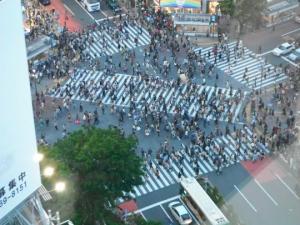
Waking up in time to be really hungry, we took advice from ‘Time Magazine’s Top 10’ and headed one stop along the train line to Ebisu where the area around the station was apparently lined with izakaya or traditional ‘hole-in-the-wall’ informal eating and drinking joints identifiable by the ‘noren’ or plastic strips over the doorways. After wandering about for a bit soaking up the atmosphere and rejecting various establishments (too many tourists / not enough people / too modern) we found our perfect izakaya; full of Japanese people, wooden and slightly ramshackle, with a table having just become free in the ‘front’ – the tiny plastic-enclosed veranda outside the izakaya proper so with a view of the street as well as into the place. We’d been resigned to using ‘the pointing finger’ but it turned out that their hand-written menu had mostly been translated, possibly by a friendly customer, into scribbled almost-English so it wasn’t too tricky at all. The two phrases I’d copied into the front cover of the phrase book: ‘Osusume’ (whatever you recommend) and ‘Nama biru onigaishimasu’ (Draft beer, please’) seemed to do the job and we ended up with an amazing feast!
Quite stuffed, we walked it off by following the railway tracks back to Shibuya through surprisingly low-rise residential areas, then ended with a nightcap at a buzzy hole-in-the-wall bar run by an expat Turkish guy.
Having had a long and action-packed day on Sunday, on Monday we got up somewhat late (okay, lunchtime) and after the inevitable 10 minutes or so playing with the toilet settings:
…we managed to get out of the hotel and go in search of food. I’d had my heart set on a kaiten (conveyor-belt) sushi place described in the guidebook but we couldn’t find it so settled for what looked like a popular-with-the-locals diner sort of place and turned out to be a fun ‘cook at your table’ canteen with a helpful English menu including cooking instructions:
Opposite the diner was a huge DVD and book store amusingly called ‘Book Off!’ – we loved this sign outside:
After lunch it was time to make some train reservations. As we were travelling on JR Pass but during Golden Week we’d been advised to reserve, however some of our chosen trains turned out to be local trains and non-reservable. Still, we had our Tokyo-Kyoto Shinkansen reservation sorted for the next day, so all good.
Then, after buying some socks (I forgot to pack any) in a local Uniqlo and going on a bit of a mission to find Randall a ‘Venti’ coffee, we headed to Akihabara ‘Electric Town’ to try and find a way to get Randall’s 3G hub working on a local SIM card. This proved to be tricky which we found surprising as it has been straightforward in all the countries we’ve travelled in before. We didn’t really have time to explore Akihabara as we were quite tired and it was very busy Golden Week but suspect we may go back, even if only to buy some crazy manga-character key-rings or something.
Back at the hotel we changed into slightly warmer clothes (socks!) and headed out into Shibuya to Nabezo which was recommended by Lonely Planet as the place to try out Shabu shabu , a kind of Japanese meat fondue. For a fixed price we could eat as much as we liked for a 90 minute period so we stuffed ourselves with the vegetable buffet whose contents we tipped into the boiling broth on our table and the delicately sliced pork and beef that we cooked by dipping it briefly in said broth:
Yum!
Another walk was called for so we wandered into the streets of Shibuya…
…almost immediately coming across what looked like an informal jam session but on the street (not busking – no money being collected) with a group of really great young musicians playing and singing a jazz/hip-hop fusion: Sanabagan
Finally we took a little self-guided tour of ‘Love Hotel Hill’:
On Tuesday we managed to get up early (5.30!!) in order to go to the Tsukiji Fish Market – the main wholesale fish market in Tokyo and thus for most of Japan. We didn’t bother trying to see the tuna auction as you have to be in the queue from 4.30am, but after a few false starts trying to find the correct entrance to Shibuya station to be able to get onto the Ginza subway line, we managed to catch the 6.01 train out of Shibuya. We’d planned to get out at Shinbashi and walk rather than changing to the line that goes right to the market. As it happened, as we were leaving the train I spotted a chap in wellies carrying a wicker basket so cunningly suggested that we follow him. He scampered out of the station and onto a waiting public bus indicated Tsuikji so we decided to do the same. It turned out that we didn’t have change, but the bus took notes up to 1000 yen; I say the bus took notes as the whole money/change thing was carried out by a mechanism with no input from the driver. Very civilised.
The market was as manic as the Bombay Sasson Dock Fish Market but in a different way; very much more mechanised, with porters zipping around on propane-powered mini-trucks/carts at great speeds. We’d had a good look around and seen (amongst assorted slithering and flopping aquatic life) a chap slicing up a huge tuna, before a market security guard spotted us and showed us a ‘no tourists until after 9am’ sign. By this time it was still not quite 7 but we felt we’d seen the best of it so we graciously bowed out.
We’d intended to have a sushi breakfast but as all the recommended places were inside the market we thought we’d wander into the centre of Ginza – the nearby business and retail district – instead. This proved to be somewhat disappointing; we thought that Japan being all industrious etc there would be things open at all hours, particularly in the business district, but as it turned out there was very little going on and nothing open. We finally found a Starbucks (free wifi) open from 7am and managed some breakfast there.
After breakfast we walked along the Ginza main drag to another station and through a bit of complicated public transport business (Subway then private railway managed to get ourselves to Tokyo Bay . We’d thought to take a river bus as a kind of scenic tour of the area (which is a kind of London Docklands but with more of a working port) but there didn’t seem to be any running so we instead took the monorail back into Shinbashi – this was a decent second best as it did a tour of the bay area, including a fly-by of the literally ‘ship-shape’ Tokyo Maritime Museum and the Tokyo Statue of Liberty before swooping back into the city, high above the streets between office blocks and apartment buildings. Another subway got us back to our hotel in time to check out at 11.
At this point Randall declined to join me on a mini-shopping trip to buy the t-shirt I’d spotted in Harajuku on Sunday:
…so he headed off to the park to chill out while I stopped at the weird vending-machine noodle bar on Basketball street for lunch, which (once I had figured out the ticketing and ordering system) turned out to be great:
and then headed up to Harajuku to poke about the shops. As it turns out I’d like to come back but with quite a bit more spare cash! (hello, Bettie Page cardigan in Hysteric Glamour for £250)
We met back up at the hotel to pick up our bags and headed to the station to catch our connecting train to Shinagawa, from where we would get on the Shinkansen to Kyoto.
Saturday 21st – Monday 23rd April: Agra
Agra is not really a place one wants to linger – it’s hassle-y and doesn’t have much to recommend it except the standard tourist sights, so we planned to get in and out in two days.
We arrived on the train in the morning, checked in to our hotel, and headed out for breakfast at a nearby rooftop restaurant with views of the Taj:
After a hearty breakfast and showers we headed out to tourist item the first: Agra Fort.
 Randall near the entrance to the Agra fort.
Randall near the entrance to the Agra fort.
 Looking over at the Taj Mahal from the fort
Looking over at the Taj Mahal from the fort
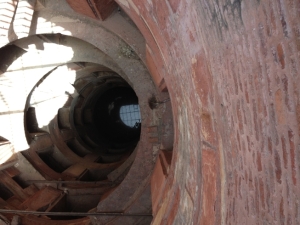 A baoli or step-well, also used for chilling out (literally) in the summer – note the little cubbies for sitting in. Goes down 25 metres.
A baoli or step-well, also used for chilling out (literally) in the summer – note the little cubbies for sitting in. Goes down 25 metres.
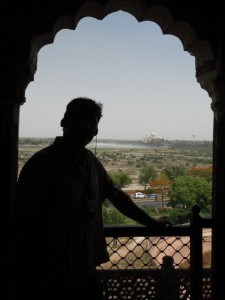 Looking over at the Taj Mahal
Looking over at the Taj Mahal
 Looking down from the marble pavilion to the Char bagh (Persian-style formal garden)
Looking down from the marble pavilion to the Char bagh (Persian-style formal garden)
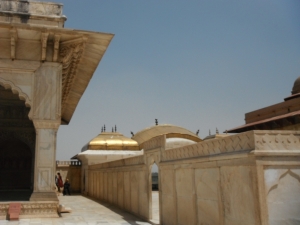 Marble pavilions and gold domes.
Marble pavilions and gold domes.
 The Char Bagh again (Char = 4, Bagh = Garden)
The Char Bagh again (Char = 4, Bagh = Garden)
 Time to go – it’s getting a bit hot now!
Time to go – it’s getting a bit hot now!
The audio guide was very good – recommended if you find yourself there; also if you go to the Taj first and keep your ticket you get Rs50 off the price of the entry to the fort.
Then it was back to the rooftop cafe for late lunch and a spot of blog writing and Skypage before watching the sunset from the top terrace:
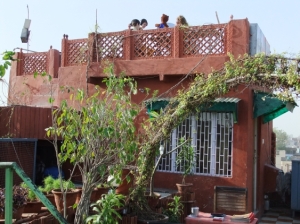 The top terrace at the Hotel Saniya
The top terrace at the Hotel Saniya
 The South Gate of the Taj, taken from the rooftop cafe, looking over the rooftops of Taj Ganj.
The South Gate of the Taj, taken from the rooftop cafe, looking over the rooftops of Taj Ganj.
 Looking down at the main roof terrace from our VIP top terrace.
Looking down at the main roof terrace from our VIP top terrace.
 Looking across to the next roof terrace restaurant.
Looking across to the next roof terrace restaurant.
The next day we got up early to be at the Taj for opening time at 6am (not ‘dawn’ as stated on all the published information!). We tried to go to the South gate, but it doesn’t open until 8am so we had to traipse back past our hotel to the West gate. Still, there were no queues at that time of the morning so we were straight in, and here is the main entrance to the Taj Mahal gardens:
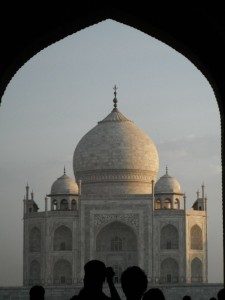 Looking through the main gate.
Looking through the main gate.
 Looking back up at the main gate – beautiful calligraphy in stone inlay.
Looking back up at the main gate – beautiful calligraphy in stone inlay.
 The main gate from inside the gardens.
The main gate from inside the gardens.
 Looking at the Taj from inside the ‘dummy’ mosque built to be symmetrical to the real mosque.
Looking at the Taj from inside the ‘dummy’ mosque built to be symmetrical to the real mosque.
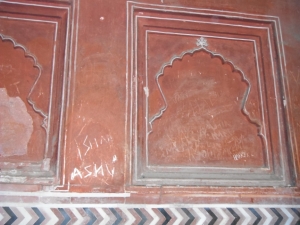 Unbelievably, loads of graffiti by Indians
Unbelievably, loads of graffiti by Indians
Back in Taj Ganj we were curious about these strange huts, which we think were stalls / sleeping spaces but we never really found out!
The Fatehpur Sikri (by Randall):
We planned a trip out to the now derelict (but ‘Archaeological Survey Of India’ protected) palace of one of the Mogul Emperors which is an hour’s drive outside of Agra. We negotiated with 3 different drivers to find the cheapest. The price started at 1500 rupees (approx. £20) and we got the all-inclusive trip for 1000 rupees. This is cheap if you work in £s and UK costs which is what most tourist are still doing when they make their very first stop at Agra to visit the Taj Mahal; and what the tourist industry are banking on. To recap, this deal was supposed to be all-inclusive but I’ll first explain what would have happened to a first-timer tourist.
After an hour’s drive the car would stop at a café owned by a friend of the driver who would significantly overcharge for fizzy drinks and the driver would get a kick-back. There is a toll road to the palace complex and the tourist would be expected to hand over 100 rupees for the toll although the toll is actually 20 rupees (the driver would expect the tourist not to notice and to keep the change). At 2Kms out from the palace the car parks are situated (understandably no parking at the palace). The road would be blocked by car park attendants competing to direct the car into their lot, and the tourist would have to pay the parking charge which is higher for foreigners. The tourist would then have to hire a rickshaw (again at inflated costs) to take them the final 2Kms. If the unofficial blockages by the car park attendants didn’t stop the tourist’s car, the Rickshaw union roadblock attended by police would.
(Helen’s note – thanks to all the books I have read set in India and my Indian friends for the tips on how to…errr…tell people somewhat forcefully to go away and engage in congress with members of their family or indeed animals. Or words to that effect.)
 Finally – at the main gate!
Finally – at the main gate!The palace complex (it’s actually multiple palaces within a walled complex) sits on top of a hill in a wide flat plain. The centre of India is hot and dry; actually semi-desert. The Moguls had planted lots of trees around the complex to provide shade and greenery. There are gardens dotted throughout which are still maintained, mostly growing vegetables and herbs. Like much Indian heritage, the palace is bare inside. What you see is the architecture unadorned and the remains of the original mosaics and inlay work. This is beautiful and certainly beats the sometimes gaudy adornments that we saw added to some South East Asian heritage sites. What is missing is information about the buildings and/or any indication of what they would have looked like or how they would have been used. There were little plaques with info – mostly describing the types of architectural detail – against most of the buildings. The info about the building’s purpose frequently did not accord with the info in Lonely Planet so we’re not sure what to believe. The palace is built out of sandstone and features lots of pavilions which we imagine would have been covered in rich fabrics and scattered with cushions. There is a very impressive 5 tier pavilion with ‘secret’ tunnels leading from the Harem. There are drained fountains everywhere and channels that would have carried water as the Moguls knew the cooling benefits of running water. It is a fantastically impressive undertaking to have raised this complex from scratch in the 1500’s. We had a lovely visit and I’d thoroughly recommend it if you have a handy Helen to deal with the scams.
View from the Buland Darwaza gate.
The rest of the photos are here.
Tweet
//
Thursday 5th – Monday 16th April: Darjeeling and the Singalila Trek
After 38 degree heat in Delhi we were looking forward to the cool in Darjeeling, however on the 4 hour jeep trip from Bagdogra airport (on the plains) up to Darjeeling at 2100m it became clear that it was a little more chilly than we had bargained for: 
Cloud, rain and thunder accompanied us, and didn’t let up after our arrival, although we did manage to get down to the main square to eat some of the great street food on offer; momos, parathas, omelettes, egg and vegetable stuffed pancakes.
The next morning it hailed, rained and thundered so hard that we were trapped in ‘Sonam’s Kitchen’ by a raging torrent running down the street:
 Taken from the doorway of Sonam’s, looking up the street towards our hostel.
Taken from the doorway of Sonam’s, looking up the street towards our hostel.
We spotted paper boats being washed down the street which was quite sweet although probably didn’t help with the major problem of blocked drains that contributed to the localised flash flooding. There was a lightening strike VERY close to us (all those tin roofs!) which may have contributed to the problems we had with electricity, hot water and phone reception over the next two days!
 This enterprising small child made a snowman from hailstones.
This enterprising small child made a snowman from hailstones.
 One of the many dilapidated or derelict old colonial buildings.
One of the many dilapidated or derelict old colonial buildings.
To be honest we’d expected Darjeeling to be a bit grander, but although there were a few signs of its past as a colonial hill station it is actually pretty down-at-heel and tatty:
 Dogs at Chowrasta, the main square.
Dogs at Chowrasta, the main square.
After a couple of days of fog, cloud and rain we were actually quite glad to set off on our seven day trek on the Singalila ridge:
 We would be walking along the border of India (West Bengal) and Nepal, and at one point almost into Sikkim.
We would be walking along the border of India (West Bengal) and Nepal, and at one point almost into Sikkim.
As we knew the trek would be pretty demanding we had booked a porter, so we bought a cheap but rather excellent rucksack to pack our bits and pieces for the week into. The trekking company we had booked with, Trek Mate, picked us up from our hostel where they introduced us to our guide ‘GD’ and took our big bags to their office for safekeeping, and put us into a jeep for the hour’s drive to Manebhanjan, the start of the trek, where we met our porter.
As the trek trail meanders between India and Nepal we had to keep our passports with us, and to sign in at the start of the trek.
After a steep climb up a ‘jeepable’ road (their term!) we stopped for morning tea near the Chitrey gompa. The locals are a mixture of hindus and buddhists and often we saw temples of both flavours next to each other.
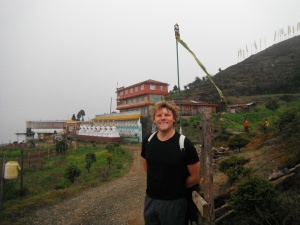 Randall on front of Chitrey gompa (buddhist monastery)
Randall on front of Chitrey gompa (buddhist monastery)
At lunchtime we stopped for instant noodles and soup and met a couple of young German hikers. Their trekking company had planned a 3 day trek for them, with them covering in a single day what we would cover in our second and third days. This sounded pretty ambitious as our third day was a sharp climb up to the first peak, Sandakhphu, at 3600m.
That night we all stayed in the same trekkers hut, the Shikar Lodge, at 2970m (a climb of 850m from our starting point at Manebhanjan).
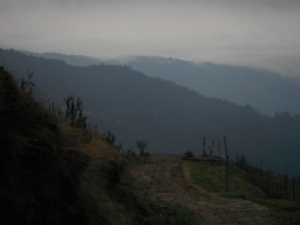 The path by which we arrived – in the clouds.
The path by which we arrived – in the clouds.
The lodge – just on the Nepali side of the border – was run by a huge Nepali woman, and was great:
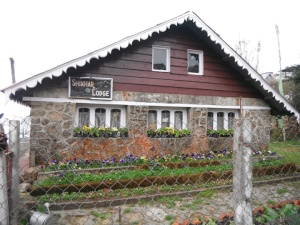 Well-kept vegetable and flower garden
Well-kept vegetable and flower garden
 Our room – basic but clean and cosy.
Our room – basic but clean and cosy.
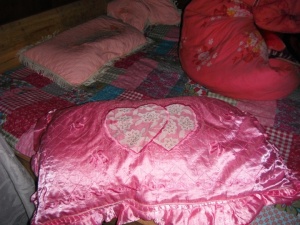 Slightly alarming frilly pink bedlinen
Slightly alarming frilly pink bedlinen
 Inexplicable tile picture of cowboys and indians in the bathroom.
Inexplicable tile picture of cowboys and indians in the bathroom.
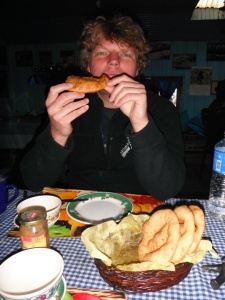 Super hearty breakfast: porridge and Tibetan bread
Super hearty breakfast: porridge and Tibetan bread
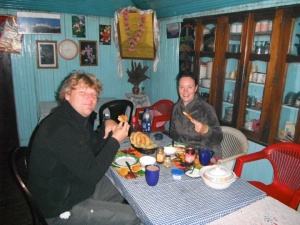 Cosy common room with open fire
Cosy common room with open fire
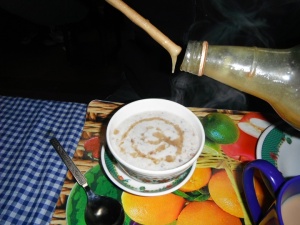 Locally made honey to put on our porridge.
Locally made honey to put on our porridge.
The next morning we actually entered the Singalila National Park:
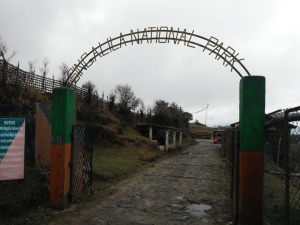 The following poster lists what tourists are supposed to do when entering the park:
The following poster lists what tourists are supposed to do when entering the park:
 Needless to say we were asked for nothing of the sort.
Needless to say we were asked for nothing of the sort.
From Manebhanjan all the way to Sandakhphu peak there was a ‘jeepable’ road that we followed some of the time. While the road provides a vital connection for the people living in the mountain villages, it inevitably means jeep-loads of Indian tourists leaving piles of brightly coloured plastic rubbish in their wake, throwing mineral water bottles out of the back of the jeep as they go, so a bit of a shame from that perspective. GD told us that the guides and porters had been lobbying for the jeep tourism service to be stopped or limited as it obviously affected their business too.
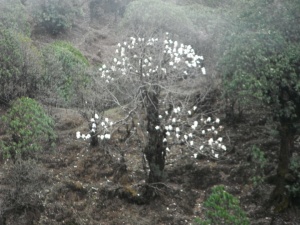 Magnolia tree – we saw these throughout the trek.
Magnolia tree – we saw these throughout the trek.
At lunchtime we caught up with Lukas and Theresa, the two Germans. They had started early but slowed down once they had heard that there would be no accommodation available at Sandakhphu that night. Their trekking company had not reserved it, and a number of people there had stayed extra nights as the weather had been bad. As Theresa was feeling unwell this was probably not a bad thing, but not a great reflection on their agency.
 Lukas and I at the lunch table.
Lukas and I at the lunch table.
We were now into the realm of no electricity except for small solar panels, so we wondered about how the locals kept themselves occupied when there were no tourists to run around after. Mainly with knitting and crocheting in this case as it turned out, as every surface and item of cookware was covered in a cosy or doily:
The hostel for this night in Kalapokhri was a bit grim:
Communal toilets and tiny rooms with wooden cots, no fire or heating in the common room, generally a bit miserable.
GD insisted that we tried the local poison ‘raksi’, a fortified wine made with ginger. Brrrrr! He also rather randomly asked everyone’s weight in kgs, and nearly fell off his chair when Randall told his…he then proceeded to tell everyone in earshot. This turned out to be a pattern – everywhere we stopped, GD would have a couple of ginger wines and then tell everyone around him, in three languages, the incredible fact of Randall’s great weight.
That night it poured with rain and hailed – in the morning we awoke to find snow on the mountain top where we were headed:
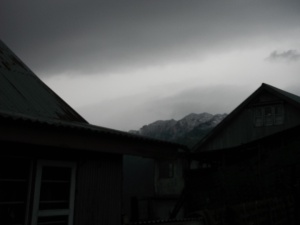 View of Sandakhphu from Kalapokhri, morning of day 3.
View of Sandakhphu from Kalapokhri, morning of day 3.
We hung around for a couple of hours waiting to see if the weather would improve as we had a short but steep walk: 3200m down to 3000m then up to the peak at 3600m, all over 7km. At around midday we decided to go for it, in full wet weather gear:
 We left the village in relative good weather – this is the view back down to where we had stayed.
We left the village in relative good weather – this is the view back down to where we had stayed.
The walk was fine – the final 2km were very steep but we stayed dry until the last ten minutes before arriving in Sandakhphu; about half a km away the cloud came down and the snow started!
The whole point of coming to Sandakhphu and walking the ridge is to see the amazing views of the Kanchenjunga range and Everest, so it was a bit of a disappointment to only have cloud and snow. Still, the next day was a 21km walk along the ridge (although actually quite a lot of up and down!) so we hoped for it to clear at some point.
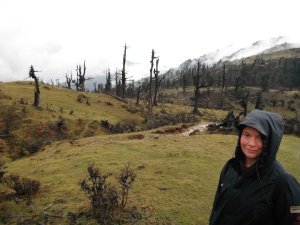 Up above the tree line on the ridge between Sandakhphu and Phalut – pretty wet and cold!
Up above the tree line on the ridge between Sandakhphu and Phalut – pretty wet and cold!
 The long and winding road (trail, anyway)
The long and winding road (trail, anyway)
Once again, we arrived in cloud with no views. The hut stood up to the gale force winds and horizontal hailstones over night with only a few leaks in the ceiling!
The next morning GD knocked on the door to get us to come up to the view point – the clouds had finally lifted, at least partially.
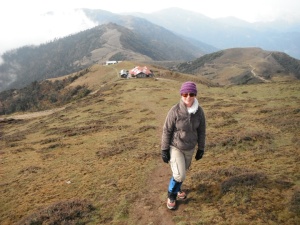 Heading up to the viewing point.
Heading up to the viewing point.
 GD looking out at the Kanchenjunga range
GD looking out at the Kanchenjunga range
 Randall trying to spot Mt Everest in the distance between the clouds
Randall trying to spot Mt Everest in the distance between the clouds
 The sleeping buddha formation in the Kanchenjunga range, sadly mostly obscured by clouds!
The sleeping buddha formation in the Kanchenjunga range, sadly mostly obscured by clouds!
 Randall and Kanchenjunga (left)
Randall and Kanchenjunga (left)
 Brrrr – time for breakfast!
Brrrr – time for breakfast!
 Yak yak yak…
Yak yak yak…
 Breakfast in the sunshine! What a treat! Randall feeding his toast to the puppy.
Breakfast in the sunshine! What a treat! Randall feeding his toast to the puppy.
The walking on day 5 was beautiful, not only because we finally had sunshine but also because we were walking down – a descent of 1300m – through lush forest.
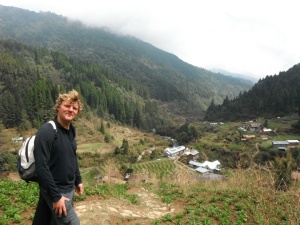 Arriving in Gorkhey for night 5
Arriving in Gorkhey for night 5
Our hut on night 5 was in Gorkhey on the border of West Bengal and Sikkim – over the river at the bottom of the valley was Sikkim.
 Empty bottle put in our rucksack at 3600m, squashed at 2300m.
Empty bottle put in our rucksack at 3600m, squashed at 2300m.
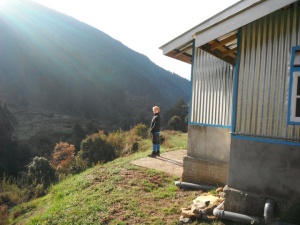 Our hut, looking over the river to Sikkim
Our hut, looking over the river to Sikkim Our hut – the ‘hotel paradise’ 🙂
Our hut – the ‘hotel paradise’ 🙂
 Inside the hotel owners’ kitchen where we ate. This is the same concrete/clay fire/oven arrangement we had seen everywhere in the previous three days.
Inside the hotel owners’ kitchen where we ate. This is the same concrete/clay fire/oven arrangement we had seen everywhere in the previous three days.
 The pretty river running down into the valley
The pretty river running down into the valley
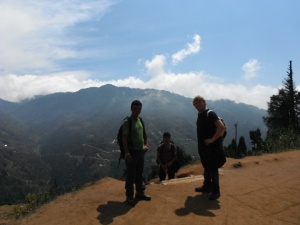 Day 6 walking – Gorkhey to Sirikhola. Stopped in the yard of a primary school to admire the view across the valley.
Day 6 walking – Gorkhey to Sirikhola. Stopped in the yard of a primary school to admire the view across the valley.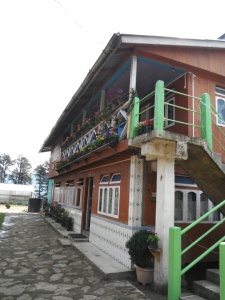 Morning tea break in Raman
Morning tea break in Raman
 Our guest house in Sirikhola – very civilised.
Our guest house in Sirikhola – very civilised.
 Bridge over the river at Sirikhola
Bridge over the river at Sirikhola

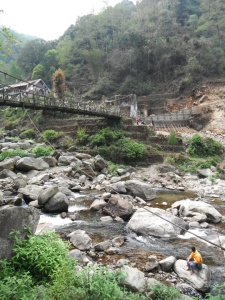
 Crazy locals ‘fishing’ with bamboo, wire and a generator, trying to electrocute the fish!
Crazy locals ‘fishing’ with bamboo, wire and a generator, trying to electrocute the fish!
 There really IS an ice cream van (or shop!) around the next corner!
There really IS an ice cream van (or shop!) around the next corner!
Arriving in Rimbik in the late morning of day 7, we were fed momos and tea before the 3 hour car journey back to Darjeeling. Phew!
After checking in to hot showers we headed to the Windamere hotel for their high tea.
 Non-residents lounge at the Windamere
Non-residents lounge at the Windamere
 Sandwiches, shortbread, marble cake, flapjacks and scones.
Sandwiches, shortbread, marble cake, flapjacks and scones.
We finally got some sunshine on Sunday:
And on Monday we finally got the amazing view over the mountains that is so famous:
Before heading to Keventners for their savage breakfast:
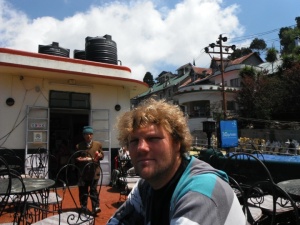 Happy man awaiting his breakfast.
Happy man awaiting his breakfast.
Between hair and beard Randall was starting to look more than a little scary so he had decided to have a shave and haircut by a local barber in the marketplace:
 Something for the weekend, Sir?
Something for the weekend, Sir?
A very satisfactory result for less than a pound!
Now back down to the plains to catch the overnight train to Varanasi.
Sunday 1st – Thursday 5th April: Delhi
After a day of relaxing and some minor shopping on Connaught Place
 Tamsin outside the legendary Wengers on Connaught Circus (hello Charlie!)
Tamsin outside the legendary Wengers on Connaught Circus (hello Charlie!)
and Janpath – FabIndia for pretty tops – on Tuesday we headed to Old Delhi’s Chandni Chowk to visit the wholesale spice market on Khari Baoli we’d been told about.
The remains of the gracious mughal city of Shahjahanabad can just about be traced behind the chaos of Delhi’s wholesale markets selling everything from paper to car parts, but the graceful courtyards and terraces have been filled with packed-in dwellings and shops housing the traders, rickshaw drivers and sweepers who live here, New Delhi’s down-at-heel neighbour, these days.
We took an autorickshaw to Chandni Chowk itself then persuaded Randall that it really would be OK for all three of us to get in a cycle rickshaw:
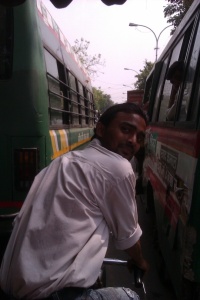 ‘Rocky’, ‘Rickshaw Pilot’ (his description!) trying to squeeze us between two buses.
‘Rocky’, ‘Rickshaw Pilot’ (his description!) trying to squeeze us between two buses.
As luck would have it, ‘Rocky’ actually lived in one of the tiny one-room apartments in the chawls that have sprung up inside the spice market so knew his way around. He took us up onto the roof (via some terrifyingly precarious stairs) from where we could see down into the building itself on one side and the courtyard of the mosque on the other side.
 Top of the spice market – you can see the classic mughal-style building around the courtyard, and the warren of buildings cobbled together inside it.
Top of the spice market – you can see the classic mughal-style building around the courtyard, and the warren of buildings cobbled together inside it.
To the far side is the mosque, where the courtyard looks more as these buildings were meant to be. Even there, the roof terraces have been put to use for drying flowers, herbs and spices:
 The old courtyards have been built up and filled in to house the hundreds of people who live and work in the building complex.
The old courtyards have been built up and filled in to house the hundreds of people who live and work in the building complex.
Inside the spice market building the air is filled with the aromas and powders of the herbs and spices, so your eyes water and throat itches. I can’t imagine what living there is like, although maybe you become immune to it.
The market was wholesale only, so Rocky brought us to a shop (where presumably he got a cut!) where Tamsin and I stocked up on everything from vanilla pods to turmeric root.
Tamsin and I wanted to go sari-shoppping (for decoration, not to wear) so Randall made his own way off and we got the ‘scenic tour’ of Old Delhi with Rocky’s running commentary, which was fun if occasionally a bit alarming. One of our favourite sights was this ‘school bus’ (of which we saw several) – a cycle-powered small cage with numerous tiny school-uniformed children stuffed (and locked) inside:
Shopping done, we headed back to Paharganj for lunch and to drop off some more tailoring (I’ve said it before, but I love how you can get ANYTHING fixed in India!) and to package up various things to be posted home. Quite exhausted from the heat and hecticness, the only answer was a night in watching TV and drinking the remains of our gin!
The next morning Tamsin and I were up early to visit Kairali, an Ayurvedic spa we’d been recommended by a woman we’d met in McLeod Ganj. We took the fabulous Metro out to Qutb Minar stop in Mehrauli – although this did involve having to shout at the security people to let us over the footbridge to reach the New Delhi metro station. Bizarre system – the only other way to reach it from the main thoroughfare Chelmsford Road is to go through the main station, which entails queueing with all the potential passengers to be security scanned and having ticket to travel. Classic bureaucracy-gone-nuts.
Still, the Ayurvedic centre was very relaxing:
 Tamsin in the reception of Kairali, just before we both had Elakizhi treatments.
Tamsin in the reception of Kairali, just before we both had Elakizhi treatments.
After the treatment – quite unlike anything either of us had had before, with two therapists really going for it with the firm massage and battering with herb-filled muslin bags – we both felt shiny and invigorated, and ready for lunch.
We met Randall at Basil & Thyme, a restaurant recommended to us by Christopher, who was sadly unable to join us. It was a lovely restaurant – all smoked salmon carpaccio and light Mediterranean main courses – a bit River Cafe, although sadly no wine as it’s not licensed. The glamorous maitress d’ even told us where the recipe for the delightful strawberry and cinnamon torte came from.
Randall headed off while Tamsin and I nipped to the salon next door for a leg-and-other-bits wax. This turned out to be an interesting experience as, before either of us realised what was happening, we had got rather more (or, indeed, less) than we had bargained for. Some cultural differences really are quite unexpected and enlightening!
To round off Tamsin’s trip we went to meet Daleep and the elusive DJ (both friends from when Charlie and I were first in India) at Aqua, the poolside bar at The Park Hotel. Nice bar, good music, good mezze menu, but the most uncomfortable selection of furniture! A good night of catching up on the past and planning for the future, topped off by Daleep having to leave because his twin sister had just gone into labour! DJ drove us back to Paharganj, very nobly not turning his nose up (much!), for a few hours sleep before an early start for the airport.
Randall and I dropped Tamsin off at the International terminal before catching our flight to Bagdogra for Darjeeling. This made us laugh:
 Casual (or indeed overt) sexism of any kind not dead here yet!
Casual (or indeed overt) sexism of any kind not dead here yet!
